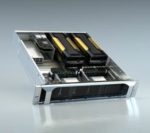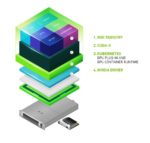Dr. Eng Lim Goh gave this talk at HPE Discover More. He describes inspiring real-world use cases that demonstrate the transformative power of AI and HPC. Hear how the next wave of Machine Intelligence is uncovering value in data like never before to solve some of the world’s most significant challenges.”
GIGABYTE Brings AI and Cloud Solutions to CES 2020
GIGABYTE is showcasing AI, Cloud, and Smart Applications this week at CES 2020 in Las Vegas. “GIGABYTE is renowned for its craftsmanship and dedication to innovating new technologies that are current with the time and helping humanity leap forward for more than 30 years. GIGABYTE’s accomplishments in motherboards and graphics cards have set the standard for the industry to follow, and the quality and performance of its products have been the excellence that competitors look up to. GIGABYTE has leveraged the experience and know-how to establish a trusted reputation in data center expertise, and is responsible in supplying the hardware and support to some of the biggest companies involved in HPC and cloud & web hosting services, enabling their successes in the respective fields.”
Why HPC is no longer just for government labs and academic institutions
In this special guest feature, Trish Damkroger from Intel writes that only HPC can handle the pending wave of Big Data coming to datacenters from Smart Cities. “While each individual city’s data footprint depends on the unique mix of smart applications deployed, you could guess that each smart city still has a lot of data to contend with. In the future, many cities may turn to AI algorithms to tap into this data to manage city operations. However, the scale of the data and need for rapid insights will make HPC-level computing resources a requirement to make the most of this opportunity.”
Video: NVIDIA EGX Edge Supercomputing Platform Accelerates AI
Today NVIDIA announced the NVIDIA EGX Edge Supercomputing Platform – a high-performance, cloud-native platform that lets organizations harness rapidly streaming data from factory floors, manufacturing inspection lines and city streets to securely deliver next-generation AI, IoT and 5G-based services at scale, with low latency. “We’ve created the NVIDIA EGX Edge Supercomputing Platform for this world, where computing moves beyond personal and beyond the cloud to operate at planetary scale.”
High Speed Data Capture for AI on the Fly Edge Applications
In many AI applications, transporting large amounts of data back to a remote datacenter is impractical and undesirable. With AI on the Fly, the entire AI workflow resides at the edge at the data source. One Stop Systems’s Tim Miller explores how high performance scalable data acquisition is a fundamental and enabling component of this emerging new paradigm.
High Performance Systems: An “Open Plan” for HPC
In this special guest feature from the SC19 Blog, Ryan Quick from Providentia Worldwide calls for a conference program that reflects more sharing across disciplines. “For me, HPC is about delivering answers to hard questions – right now. It’s about an inclusive and integrative approach to computing. And it’s exciting. If we can put aside our differences and allow ourselves to learn a little. We will gain a lot. I promise. See you in Denver.”
Why Hardware Acceleration Is The Next Battleground In Processor Design
In this special guest feature, Theodore Omtzigt from Stillwater Supercomputing writes that as workloads specialize due to scale, hardware accelerated solutions will continue to be cheaper than approaches that utilize general purpose components. “If you’re a CIO who manages integrations of third-party hardware and software, be aware of new hardware acceleration technologies that can reduce the cost of service delivery by orders of magnitude.”
New NVIDIA EGX Platform Brings Real-Time AI to the Edge
Today NVIDIA announced NVIDIA EGX, an accelerated computing platform that enables companies to perform low-latency AI at the edge. “The combination of high-performance, low-latency and accelerated networking provides a new infrastructure tier of computing that is critical to efficiently access and supply the data needed to fuel the next generation of advanced AI solutions on edge platforms such as NVIDIA EGX.”
DDN Moves Closer to the Edge with Nexenta Acquisition
Today DDN announced its intent to acquire Nexenta, the market leader in Software Defined Storage for 5G and Internet of Things (IoT). “Our clients benefit from the flexibility and performance of Nexenta’s robust SDS solutions and platform-agnostic strategy, which provide great differentiation for the HPC, AI, and high-performance data analytics (HPDA) verticals we serve. With escalating demands from our clients for ultra-scalable compute and data storage platforms, we look forward to the exciting developments which will result from this new relationship.”
Julia 1.0 release Opens the Doors for a Connected World
Today Julia Computing announced the Julia 1.0 programming language release. As the first complete, reliable, stable and forward-compatible Julia release, version 1.0 is the fastest, simplest and most productive open-source programming language for scientific, numeric and mathematical computing. “During the last six and a half years, Julia has reached more than 2 million downloads and early adopters have already put Julia into production to power self-driving cars, robots, 3D printers and applications in precision medicine, augmented reality, genomics, energy trading, machine learning, financial risk management and space mission planning.”













